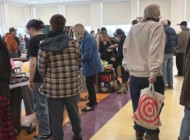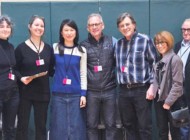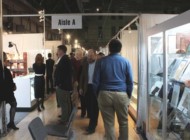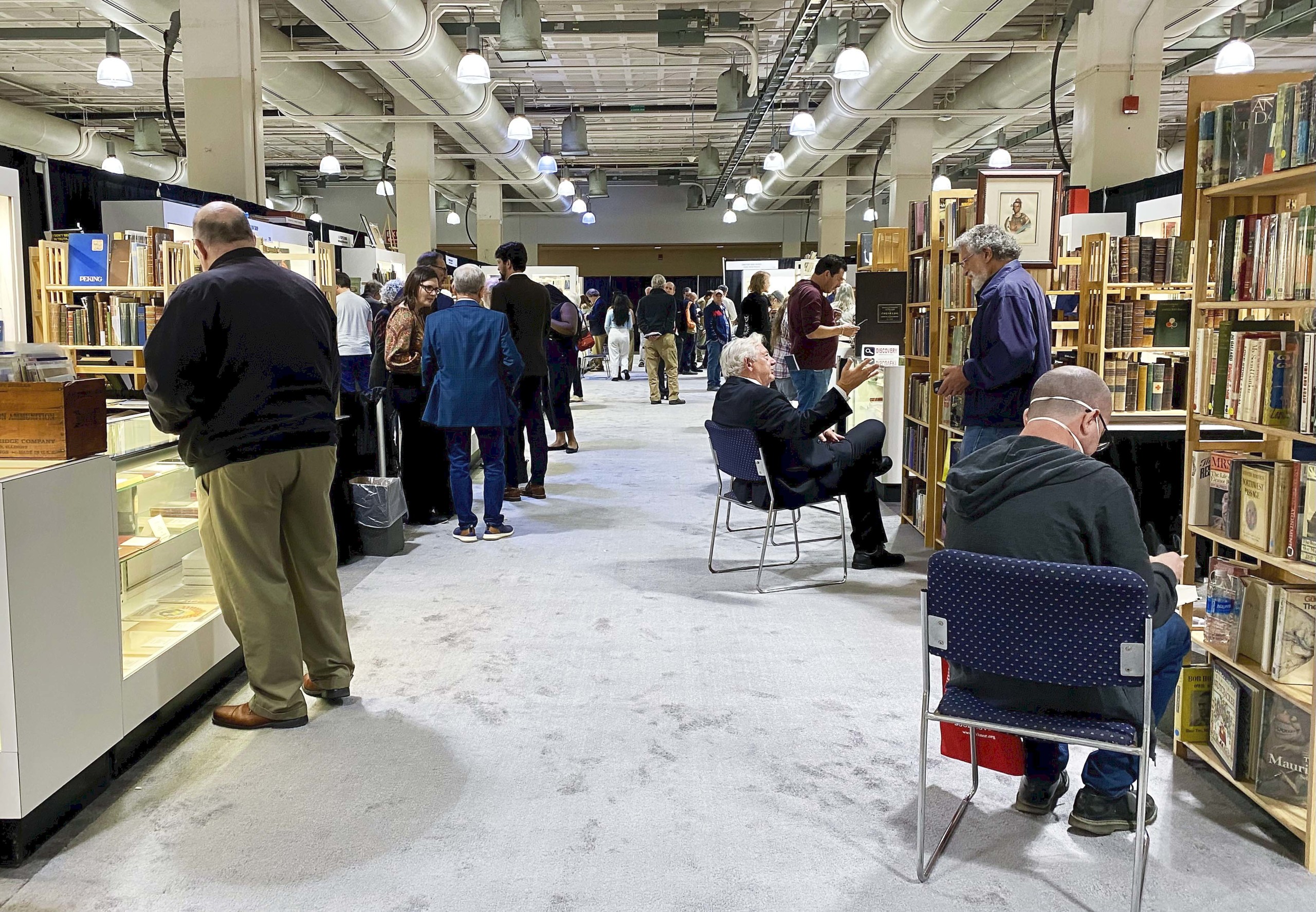
Within an hour after this photo was taken at opening, the aisles were filled with shoppers on Friday night.
Review & Onsite Photos by Z.G. Burnett
BOSTON, MASS. — Events such as the Boston International Book Fair become more and more important with each passing year. In an increasingly digital world, they remind us of a time when books were treasures to be guarded and passed on. Anyone who’s tried to track down a specific edition of a childhood storybook or a thesis that was only printed in 50 copies by a university press will understand the relative scarcity of texts before a certain year. Under the Antiquarian Booksellers’ Association of America’s (ABAA) banner, dealers from around the globe gathered at the Hynes Convention Center from November 8 to 10 to carry on this tradition and inspire new collectors to build their own libraries. With attendance up 20 percent from last year and great feedback from dealers, interest in rare books, book arts and other ephemera only seems to be growing.
“Sales were good,” said Sheryl Jaeger of Eclectibles, Tolland, Conn. “But equally exciting was the number of young people in attendance and their enthusiasm for the materials!” Eclectibles offered a variety of goods related to the transformation of childhood culture, women’s history and the social history of advertising. This colorful range attracted both the young and the young at heart, perhaps helping collectors reconnect with their inner child. One of the best examples of this was an excellent pair of Fairies’ Wings produced by J. & P.B. Myers of New York City in the 1920s. Made for a child’s costume, the wings were lithographed in gold and light peach-colored ink dusted with flaked mica, which Jaeger referred to as “nature’s glitter!” Instructions were even printed on each die cut tissue paper wing. Luckily for us, these delicate wings seemed not to have been worn and presented perfectly on the wall of Eclectibles’ booth.

These pretty patented Fairies’ Wings from the 1920s had not yet flown away to their new home and are still available from Eclectibles, Tolland, Conn.
With the Miniature Book Society (MBS) looking on, many dealers brought books small enough to suit a child’s hands, but often with weightier subject matter. Sandra L. Hoekstra Bookseller, Thomaston, Maine, displayed an appealing collection with a range of dates and topics. The earliest of these was a Seventeenth Century Dutch Psalm book translated by the Calvinist Dutch theologian Pietre Datheen (1531-1588) bound between ochre flame tortoiseshell boards clamped by silver hinges and clasps. A later, more unusual title was a limited edition, numbered book by Robert L. Merriam, The History, Romance, Mythology, and Production of Maple Syrup (1982). It contained the bookplate of Robert E. Massmann (1924-2013), former president of MBS. One of the tiniest books presented was a 1929 edition of “Lincoln’s Addresses” from the training division of Kingsport Press, Tenn., not meant explicitly for reading, but rather to show off the binder’s skill.
The largest concentration of Lincoln materials was found where else but the Abraham Lincoln Book Shop of Chicago’s booth. The most intriguing item offered, however, was not a book, but a mourning fan made in 1866 following the president’s assassination. Produced in Havana, Cuba, the fan was presented at the World’s Fair of 1867 in Paris and retained its original case. The fan itself was made from embossed aluminum, which supported two-sided, painted and lithographic paper leafs. Bibliopole Daniel R. Weinberg explained that this patented design had a variant wherein the end medallion contained a concealed blade. On one side, the fan showed battles of the Civil War and scenes from Lincoln’s assassination, and on the other, a portrait of Lincoln surrounded by cherubs, flanked by columns and panels of sheet music. Weinberg reported “reasonably good” sales, but the fan is still available.

This elaborate mourning fan was worthy of the 1867 World’s Fair in Paris, with its patented aluminum design paying lithographed respects to the late president Abraham Lincoln. Abraham Lincoln Book Shop Inc. Photo courtesy of Eric Langlois. Chicago
While a fan depicting a presidential assassination bridged collectors of decorative arts and Civil War history, another document brought by Elizabeth Kelly-Griswold of Blue Mango Books, New Hope, Penn., checked boxes for Temperance movement and fraktur enthusiasts alike. Probably made in the 1840s, the watercolor from the Sons of Temperance was addressed to Mr John Myles and contained an original dedication composed in his honor. Myles was a member of the Taunton (Mass.) Total Abstinence Society in 1842, as well as a member of the Washington Total Abstinence Society. The columns and urns on the document were typical Nineteenth Century mourning iconography, but Myles is believed to have died in 1873. These are festooned with artistic flourishes and colors more commonly seen in Fraktur documents by the Pennsylvania Dutch, as is the headline font from which the style earned its name. Kelly-Griswold confirmed that the Temperance fraktur sold during the “amazing” show, as did an 1811 music manuscript of patriotic and secular songs by Roxellana Gere (1782-1865) and a book with a bookplate engraved by Paul Revere.
About a century later and on the other side of the bar was a first edition of Old Mr Boston Says ‘Here’s How’ With 24 Famous Recipes, the pamphlet that preceded the iconic bartender’s guide from Rabelais Books, Portland, Maine. These were printed to instruct new bartenders, yesteryear’s mixologists, to concoct the most popular gin cocktails of the 1930s. The guide was in remarkable shape as the paper would normally get wet and turn to pulp, and the colors were still vibrant. Old Mr Boston Gin is no longer in production, so if you’re attempting to reproduce any of these recipes, make sure the replacement’s flavor profile matches the drink’s other ingredients.
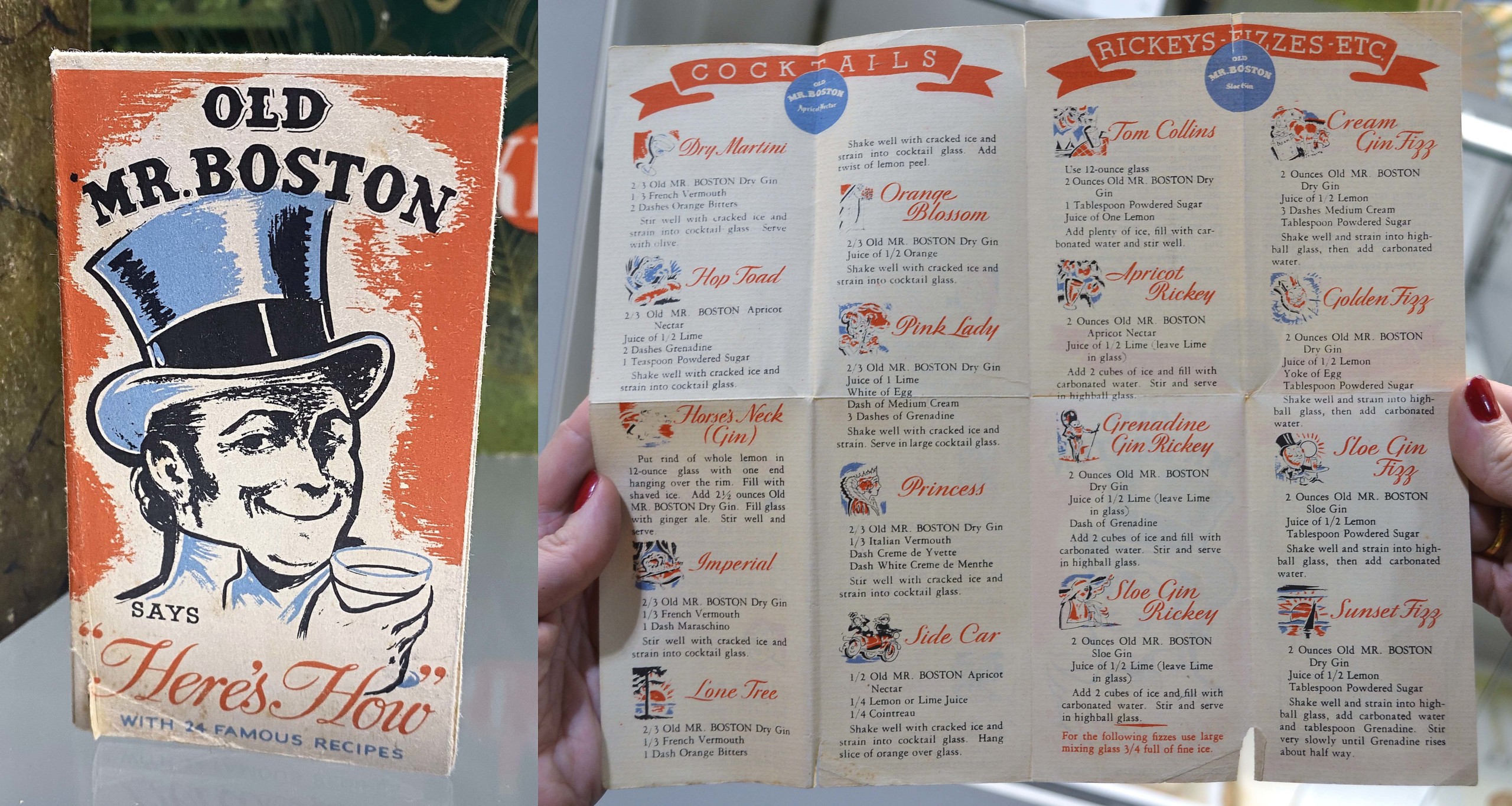
A first edition of Old Mr Boston Says ‘Here’s How,…’ 1934, from Rabelais Books. Photo courtesy of Eric Langlois. Portland, Maine.
Fun and games aside, the presidential election days earlier was this show’s elephant in the room and dealers selected their wares accordingly. Scientia Books, Arlington, Mass., showcased a large collection of books written by and about women in the sciences. The earliest of these was the premier European book of obstetrics published by the prominent French midwife Louise (Boursier) Bourgeois (1563-1636). Bourgeois was the royal midwife to the court of King Henry IV, and this was a first edition, first issue of the 1609 text, published a year before Henry’s death. Owner Malcolm Jay Kottler also pointed out a 1755 printing of Dorothea Erlexen’s dissertation, the first German woman to become a doctor of medicine in 1754. Elizabeth Maxwell followed, becoming the first American woman doctor in 1849, and Scientia offered a number of her works, as well.
Other provocative materials could be found throughout the show, including A Year Among the Girls, written by Donald Allen Wolfheim (1914-1960) under the name Darrell G. Raynor, from DeWolfe & Wood Rare & Used Books, Alfred, Maine. Wolfheim was a science fiction author who spent a year at Casa Susanna in the Catskills, a resort known as a safe space for cross-dressing men and transgender women, himself dressed as a woman and studying the sociology of this marginalized group. Printed in 1966, this copy was deaccessioned from the library of the National Council of Crime & Delinquency in Hackensack, N.J.
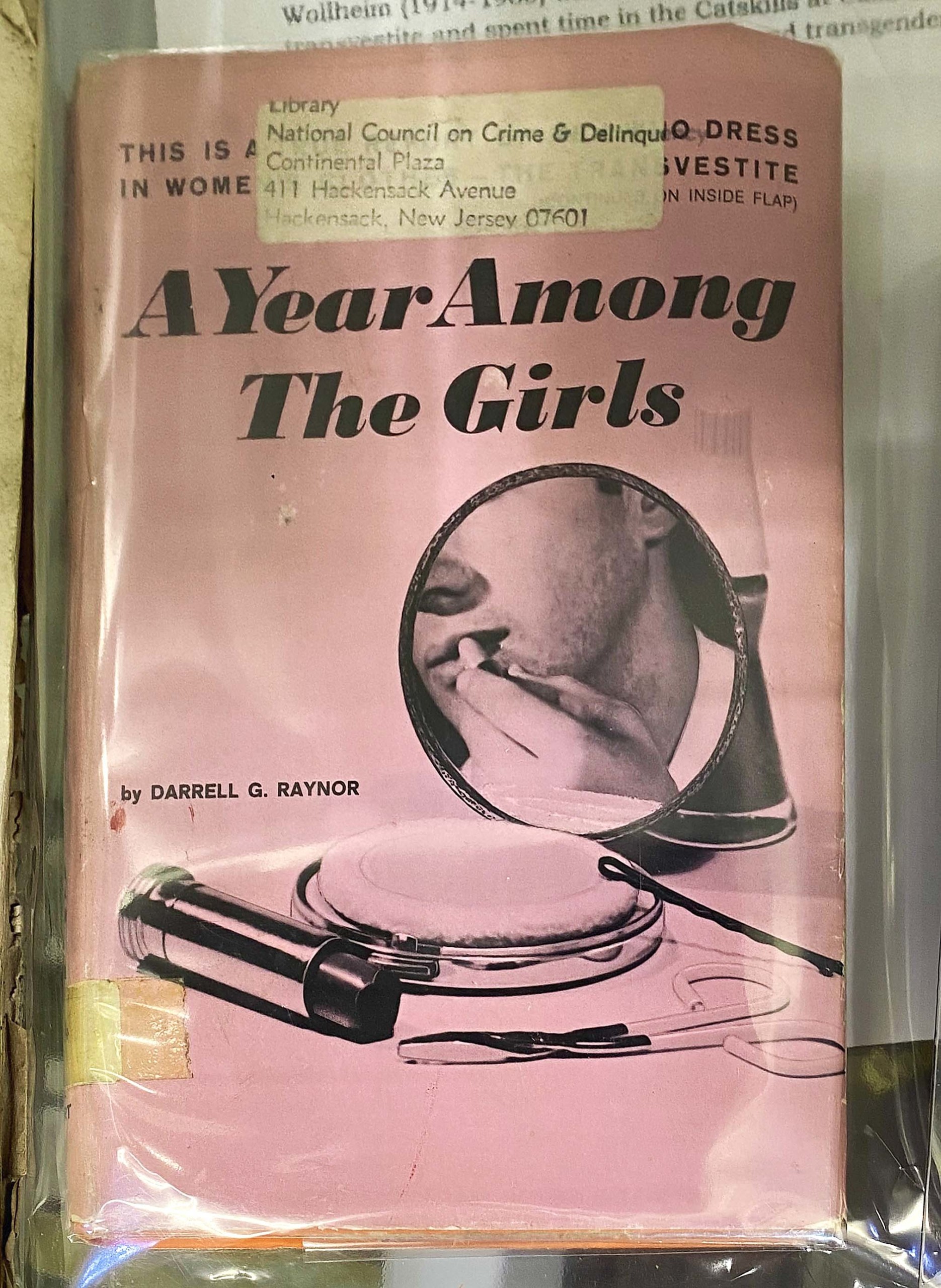
An ex-library copy of A Year Among the Girls by Darrell G. Raynor, the author’s memoir of his year spent at an LGBTQ+ resort in the 1950s, offered by DeWolfe & Wood Rare & Used Books, Alfred, Maine.
Examples of contemporary political iconography were also present. The familiar face of Guy Fawkes from the 2005 movie adaptation of Alan Moore and David Lloyd’s 1982-85 graphic novel V For Vendetta was spotted in the Kaaterskill Books, East Jewett, N.Y., booth on a 2017 linocut by award-winning Mexican artist Sergio Sanchez Santamaria (b 1976) titled “Poder del Pueblo (Power to the People).” Appropriated by the political hacktivist group Anonymous, Santamaria shows a protester wearing the enigmatic mask while holding corn, flowers and a scythe. The illustrated phrase “Para todos todo” is used by the Zapatista Army of National Liberation as the beginning of the rallying cry, “Everything for Everyone, Nothing for Ourselves.” The Zapatistas are a movement representing indigenous sovereignty and freedom from economic oppression imposed by the Mexican state, but has experienced dissolution in recent years.
Technology was another popular subject, with the breadth of materials available demonstrating the evolution of human exploration and communication and the time it takes for any innovation to become obsolete. An unassuming wooden tablet in the case of Konstantinopel Rare & Fine Books, Enschede, The Netherlands, was the first appearance of western cursive writing; not the first concept that comes to mind as technology, but a form of writing that may disappear within the next century. Inked on both sides, the tablet was composed for the tutorship of Iulius Manus in 282 CE. From the catalog description, “The script contained herein is Later Roman, the ultimate precursor of all medieval minuscule scripts and, therefore, of our own lower-case alphabet. This makes the tablet not just an artifact of ancient writing, but a crucial link in the evolution of Western script.” The tablet was still available at press time.
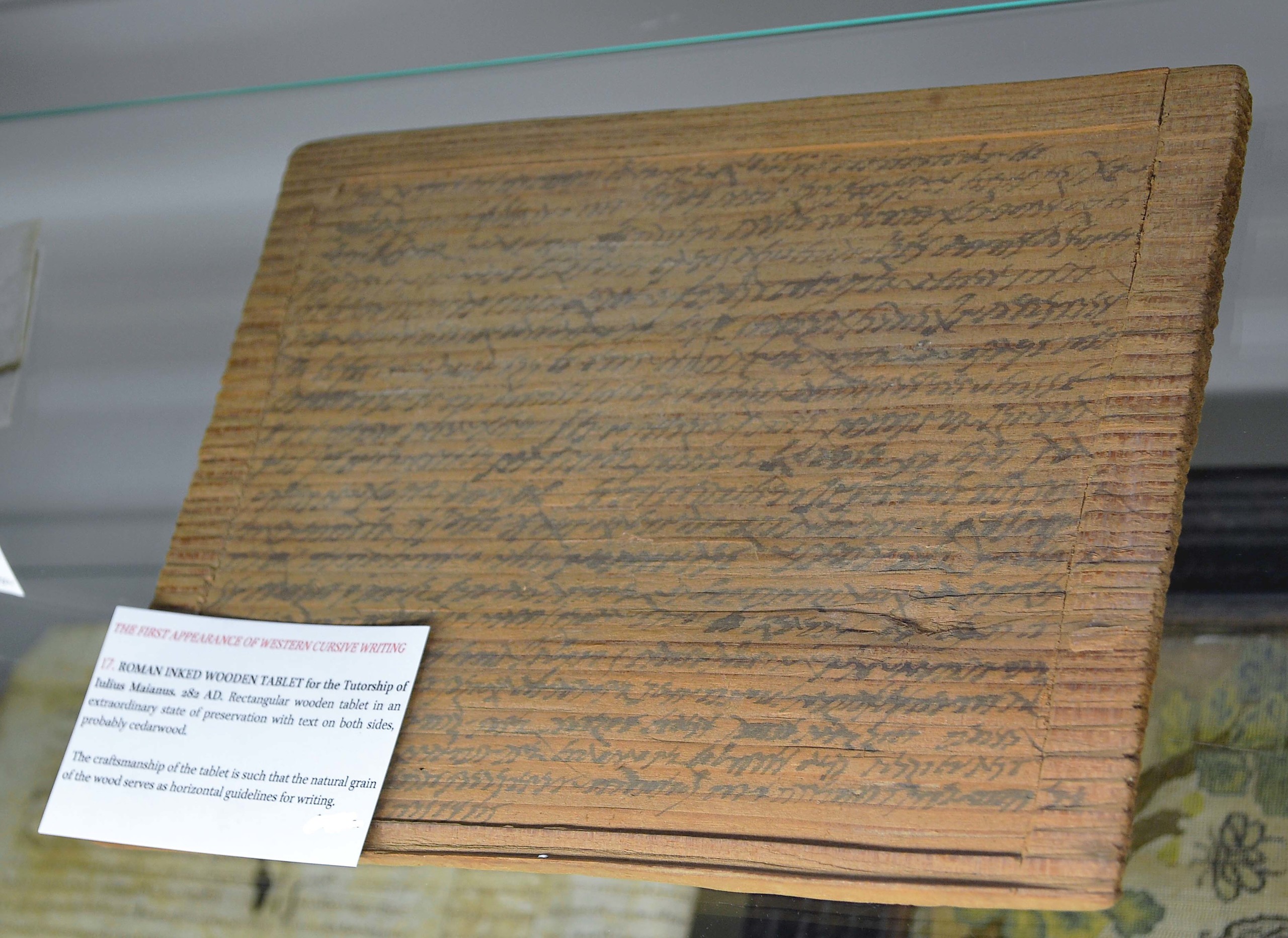
This ancient Roman cedarwood table was one of the earliest extant documents at the show, and in the world, showing cursive writing similar to that which is still used today and taught in schools up until the last couple of decades. Konstantinopel Rare & Fine Books, Enschede, The Netherlands. Photo courtesy of Eric Langlois.
Returning to the Twenty-First Century, Kuenzig Books, Topsfield, Mass., brought a fascinating example of how technological leaders are currently finding new ways to implement cyberspace into actual space. A City from the Internet Up: Project Sidewalk, also known as The Yellow Book, was an internal document of Sidewalk Labs formed by Google and ex-Bloomberg CEO Dan Doctoroff. The goal of Project Sidewalk was to create “innovation laboratories” in major American cities to explore the potential of internet-based structural principles to actual urban infrastructure. Doctoroff wrote in The Yellow Book’s foreword, “We began the painstaking process of rethinking the city in its entirety from the internet up… Our approach is to reconceive the city as a platform built on the foundations of ubiquitous connectivity and seamless data and analytics (protected by a novel approach to data privacy), core physical infrastructure, and basic principles of governance. It recognizes that the beauty of the best platforms — and of the best cities — is that they evolve over time as tastes and technologies and needs change…” The concept began its first developments in 2017, but plans were dropped in 2020. Kuenzig Books had not yet seen another copy in the marketplace.
The ABAA Boston Antiquarian Book Fair occurs annually at the Hynes Convention Center, 999 Boylston Street. For information, 212-944-8291 or www.abaa.org.

























